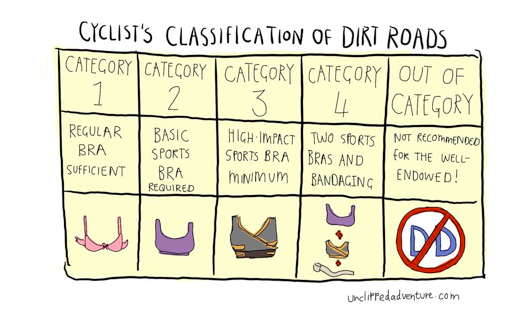Traveling through Africa, that is one girl’s expression of exasperation at the incessantly bumpy roads that have been dominating her journey.
Thankfully, most of us do most of our pedaling on something smoother, but we still need support, so here is my guide to choosing a sports bra for cycling.
Know your size
The first rule of all bra-buying is to know your size. Sports bras don’t have underwire and generally aren’t measured in cup sizes.
They can use dress sizes, but tend to be the dreaded small, medium, and large – and can also come in packets that stop you trying them on (annoying!).
So, get measured, or measure yourself, taking readings from around the very top of your rib cage, and from around your torso over the bust.
Understand impact levels
The second rule of bra-buying is: the bigger the bust, the more support it needs. When you’re looking for the right sports bra, though, there’s an extra support criteria to consider, and that’s the impact level.
A sports bra designed for running is going to prevent more bounce than a sports bra designed for yoga, for example. A running bra is high-impact and a yoga bra is low-impact.
For most cycling activities, medium- or low-impact sports bras will do, but if you fancy a day of shredding trails on a hardtail, you might want to upgrade!
Breathability
Once you’re clued up on size and impact level, the next job is deciding on material, and this depends on the intensity of your cycling, your own body’s behavior, and your climate.
A criterium racer living in France will want to look for a sports bra that is light, highly breathable and dries fast, whereas a commuter living in Sweden might only need a cheaper, heavier sports bra, that has the added bonus of keeping out wind chill.
Choosing style
Sports bras can be traditional, plain and simple, or they can be neon pink with spaghetti straps. What you prefer is mostly up to you when you’re choosing a sports bra for cycling, but there are key things to remember.
Bigger straps will generally give greater support, and traditional shoulder straps can be shortened or lengthened easily for a better fit.
Some brands cleverly give you the racer back and shoulder straps, by adding a connector that draws the shoulder straps into racer back mode. That increases the impact level the bra is suitable for, so you effectively get two bras for the price of one.
About brands
Most sports brands now make sports bras and it’s hard to gauge whether they are better than the sports bras made by lingerie brands.
Sports brands have a wealth of sports knowledge that they apply to making their sports bras, and lingerie brands know busts inside and out. There are plusses and minuses, and maybe we’ll review a selection from each industry soon.
After 15 years of horse riding, cycling and running, what I know for sure is that I don’t stray away from Shock Absorber. They are one of the first specialist sports bra designers and manufacturers, launching in 1994, and they have developed a very beginner-friendly levels system for grading their bras. Lately, they’ve upped the style stakes too.







